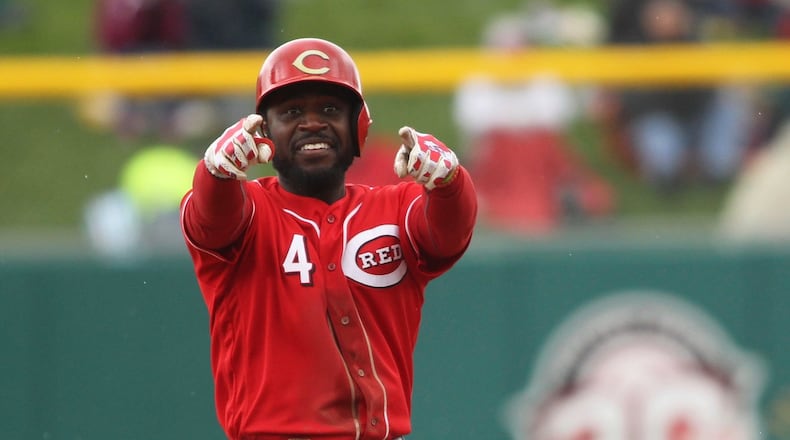Q: We often hear that the worst trades in Reds history involved sending away Frank Robinson and Tony Perez, but what do you consider was the best trade they ever made? — TIM, Xenia.
A: You can add Roberto Kelly for Paul O’Neill on the gosh-awful list. And everybody knows that Bob Howsam’s deal with Houston that brought Joe Morgan, Jack Billingham, Cesar Geronimo and Ed Armbrister to the Reds that completed construction of The Big Red Machine was one of baseball’s all-time best. I also like three deals former general manager Wayne Krivsky made in 18 days at the end of spring training in 2006. On March 20, he traded Wily Mo Pena to Boston for Bronson Arroyo. The next day he traded minor-league pitcher Bob Basham to San Diego for catcher David Ross. On April 7, he traded minor-league pitcher Jeff Stevens to Cleveland for Brandon Phillips. That was a trading trifecta. And speaking of deals, Krivsky got a raw one. Remember when manager Tony Perez was fired after 44 games? Krivsky beat that. He was fired as GM 22 games into the 2008 season.
Credit: Staff photo by Ron Alvey
Credit: Staff photo by Ron Alvey
Q: Why don’t managers bunt the ghost runner on second to third, especially the home team when the score is still tied? — BRIAN, Troy.
A: This one drives me off the road, too. If the score is still tied in the bottom of the 10th, one run ends it. Why not bunt that runner to third? There are so many more ways a runner can score from third than he can from second. Some examples: wild pitch, passed ball, wild pick-off throw, an error by an infielder, a sacrifice fly, a slow ground ball to the right side, a squeeze bunt, a safety squeeze, an infield hit, a steal of home, runner interference. The only thing I can come up with is that analytics say not to do it. Managers are squeamish about giving up outs.
Q: What are your thoughts on Curt Casali catching 75 percent of the games and DHing the rest of the time? — STEVE, Vandalia.
A: There is no doubt that Casali is a Picasso behind the plate but a finger-painter in the batter’s box. The Reds seem to win most of the time when he catches. He is a master at handling pitchers, especially young ones, and running a game. But you need to check statistics before making him a DH. In his first 69 plate appearances this season, his slash line is .172/.284/.207. He is not Yogi Berra or Johnny Bench with a bat in his hands.
Q: Does an umpire get real-time feedback during a game when his strike zone is terrible? —KEVIN, Springboro.
A: The only real-time feedback is screams and epithets from the dugouts and boos from the fans. Retired umpires used to sit in the press box jotting notes and then would go to the umpires’ dressing room after the game to discuss their work. Randy Marsh was a regular in Great American Ball Park. But now, with so much video, an umpire’s work is viewed in New York. They are graded and bad performances are discussed.
Q: Why isn’t relief pitcher John Franco in the Cincinnati Reds Hall of Fame? — TOM, Cincinnati.
A: As do you, I believe he belongs. He had 140 saves with the Reds, third behind Danny Graves, who was inducted last year with 182 saves. Francisco Cordero is second with 150 and he isn’t in. But Clay Carroll with 119 saves and Pedro Borbon with 76 saves are both in. I’m not saying Carroll and Borbon don’t belong. They were major parts of The Big Red Machine. I’m saying Franco belongs. And why not put the three Nasty Boys — Norm Charlton, Randy Myers and Rob Dibble in together as one entity?
Q: Do you think the Reds good-looking rookies will hit a wall and slide backwards? — JOE, Centerville.
A: Many fast-starting rookies become quick fizzles. Aristides Aquino anybody? Pitchers probe and probe to find weaknesses. If they find them, the hitter must adjust. Right now, they are trying to find a chip in Matt McLain’s armor with every type of pitch and every possible location. So far, they’ve been unsuccessful. If they eventually find one, McLain (and any rookie) must be ready to adjust.
Q: Do the Reds bring up most of their players from Louisville and do they ever go from Dayton to Triple-A? — MELANIE, Troy.
A: There are steppingstones most players must climb en route to the majors. Most start at low Class A Daytona Beach, advance to high A Dayton, then to Class AA Chattanooga, then to Class AAA Louisville. Since Louisville is the highest step where final polish is applied, most Reds promotions are from Louisville. Occasionally, not often, a player jumps from Class AA Chattanooga to the majors, usually a pitcher. Players from Dayton advance to Class AA Chattanooga, never directly from Dayton to Louisville. Even Elly De La Cruz had to make a stop in Chattanooga.
Q: The Reds have Tom Browning’s 1990 World Series ring displayed along with one given to his wife, Debbie, so do wives always get World Series rings? — SCOTT, Columbus.
A: No, they don’t. But owner Marge Schott loved Debbie Browning and I’m sure she was a special case. When Browning pitched his perfect game, Mrs. Schott gave him a pat on the back and gave Debbie a fur coat.
About the Author

